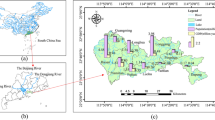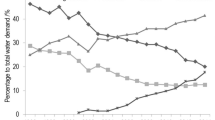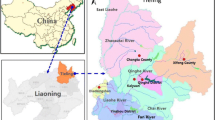Abstract
Based on system dynamics approach, SDMUWEIC model is developed in order to evaluate future dynamics of urban water infrastructure development in China. Firstly, this paper presents the basic structure and characteristics of the model, focusing on water infrastructure’s dynamic relationships with population increase, economic development, water resources shortage and water conservation practices. Secondly, model veracity and robustness tests based on behavior reproduction and uncertainty analyses are illustrated. Thirdly, based on the model, future patterns of China’s urban water infrastructure investment requirements are simulated, and effectiveness of two different policy scenarios are evaluated. Finally, conclusions and policy implications are drawn, allowing insights into China’s sustainable water infrastructure policies and managements.
Similar content being viewed by others
References
ADB, Handbook for the Economic Analysis of Water Supply Projects: Guidelines, Handbooks, and Manuals, Asian Development Bank, 1999.
Barlas, Y., “Formal aspects of model validity and validation in system dynamics”, System Dynamics Review, Vol. 12, No. 3, pp183–210, 1996.
Barlas, Y., “Multiple tests for validation of system dynamics type of simulation models”, European Journal of Operational Research, Vol. 42, No. 1, pp19–87,1989.
Barlas, Y. and A. Erden, “Output behavior validation in system dynamics simulation”, Proceedings of the European Simulation Symposium, Istanbul, Turkey, pp81–84, 1994.
Beck, M.B., “Water quality modeling: a review of the analysis of uncertainty”, Water Resource Research, Vol. 23, No.8, pp1393–1442,1987.
Bhatia, R., R. Cestti and J. Winpenny, Water Conservation and Reallocation: Best Practice Cases in Improving Economic Efficiency and Environmental Quality, Washington, D.C.: The World Bank, 1995.
Charles, M., “US water infrastructure faces funding shortfall”, Civil Engineering, Vol. 70, No. 6, pp12, 2000.
Chu, J.Y. Financing of urban environmental infrastructure under transit economy of China, B.S. thesis of Tsinghua University, 2000.
Chu, J.Y., J.N. Chen and J. Zou, “Analysis of financing mechanisms for urban water infrastructure”, Environmental Protection, Vol. 12, pp18–21, 2001a.
Chu, J.Y., J.N. Chen and J. Zou, “Quantitative analysis on the contribution of urban water supply industry to national economy”, China Water & Wastewater, Vol. 17, No. 12, pp21–24, 2001b.
Chu, J.Y., J.N. Chen and J. Zou, “Future scale and market capacity of urban water environmental infrastructure in China: a system dynamic model”, Environmental Science, Vol. 23, No. 4, pp1–7, 2002a.
Chu J.Y., J.N. Chen, Z.H. Wang, Z.G. Wen and Y.J. Xu, “Economic comparison on the reclaimed water reuse schemes and analysis on the potential of reclaimed water utilization”, China Water & Wastewater, Vol.18, No.5, pp83–86, 2002b.
Chu, J.Y., J.N. Chen and J. Zou, “Quantitative analysis on investment efficiency in urban wastewater treatment plant in China”, China Water & Wastewater, Vol. 18, No. 3, pp27–29, 2002c.
Dinar, A., The Political Economy of Water Pricing Reforms, New York: Oxford University Press, 2000.
Ford, A., Modeling the Environment: An Introduction to System Dynamics Models of Environmental Systems, Washington, D. C.: Island Press, 1999.
Forrester, J.W., Industrial Dynamics, Cambridge, Massachusetts: The MIT Press, 1961.
Grima, A.P., “The impact of policy variables on residential water demand and related investment requirements”, Water Resource Bulletin, Vol.9, No.4, pp703–710, 1973.
OECD, Household Water Pricing In OECD Countries, Working Party on Economic and Environmental Policy Integration, 1999.
Jones, C.V., J.J. Boland, J.E. Crews, C.F. DeKay, and J.R. Morris, Municipal Water Demand: Statistical and Management Issues, Boulder, Colo: Westview Press, 1984.
Kessides, C., The Contributions of Infrastructure to Economic Development: A Review of Experience and Policy Implications, Washington, D.C.: the World Bank, 1993.
Lee, T.R., Residential Water Demand and Economic Development, Canada: University of Toronto Press, 1969.
Mao, Y.S. D.T. Ning, G. Xia, H.C. Wang and S. Vaclav, An Assessment of the Economic Losses Resulting from Various Forms of Environmental Degradation in China, Occasional Paper of the Project on Environmental Scarcities, State Capacity, and Civil Violence, Cambridge: American Academy of Arts and Sciences and the University of Toronto, 1997.
Nieswiadomy, M.L., “Estimating urban residential water demand: effects of price structure, conservation and education”, Water Resources Research, Vol. 28, No. 3, pp609–615, 1992.
O’Regan, B. and R. Moles, “An insight into the system dynamics methods: a case study in the dynamics of international minerals investment”, Environmental Modeling & Software, Vol.16, pp339–350, 2001.
Serageldin, I., Water SUPPLY, Sanitation and Environmental Sustainability, Washington
D.C: the World Bank, 1994.
Sterman, J.D., Business Dynamics: Systems Thinking and Modeling for a Complex World, Boston: Irwin/McGraw-Hill, 2000.
Wolstenholme, E.F., System Enquiry: A System Dynamics Approach, New York: John Wiley & Sons, 1990.
Author information
Authors and Affiliations
Additional information
This work was supported by the National Natural Science Foundation of China under Grant 70073040
Junying Chu is a Ph.D Candidate of Environmental System Analysis Institute, Department of Environment Science and Engineering, Tsinghua University, Beijing, China. She obtained B.Sc in Environmental Engineering and B.Sc in Business Administration from Tsinghua University in 2000. Her research focuses on issues related to water policy analysis, environment system analysis and complex system simulation.
Jining Chen is Professor of Department of Environment Science and Engineering, Tsinghua University, Beijing, China. He received the Ph.D degree in Environmental Systems Analysis from Imperial College in 1992. He takes a keen interes in system analysis, modeling, computing, technology assessment, river basin management, hydrology, operation and control of wastewater treatment plants and policy analysis.
Ji Zou is Professor of Department of Environmental Economics and Management, Renmin University of China, Beijing. He received the Ph.D degree in Environmental Economics from Renmin University of China in 1997. His areas of research interest include economic analysis of environmental impact assessment, analysis on instruments of environmental policies, policy and institutional analysis on environmentally-friendly technology transfer, techniques for environmental valuation, and international financial flow and the environment.
Rights and permissions
About this article
Cite this article
Chu, J., Chen, J. & Zou, J. Perspectives on urban water infrastructure in China for the 21st century: SDMUWEIC model. J. Syst. Sci. Syst. Eng. 12, 470–480 (2003). https://doi.org/10.1007/s11518-006-0148-0
Issue Date:
DOI: https://doi.org/10.1007/s11518-006-0148-0




